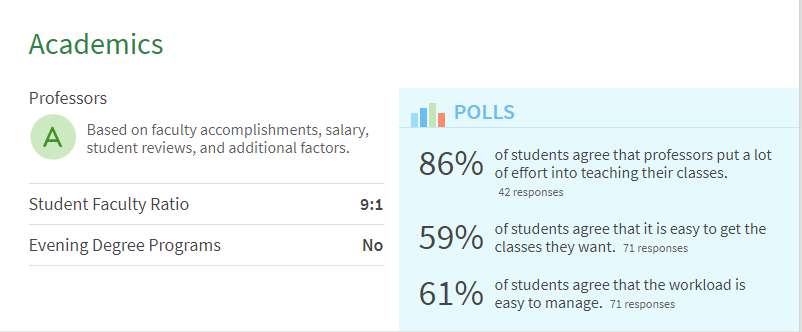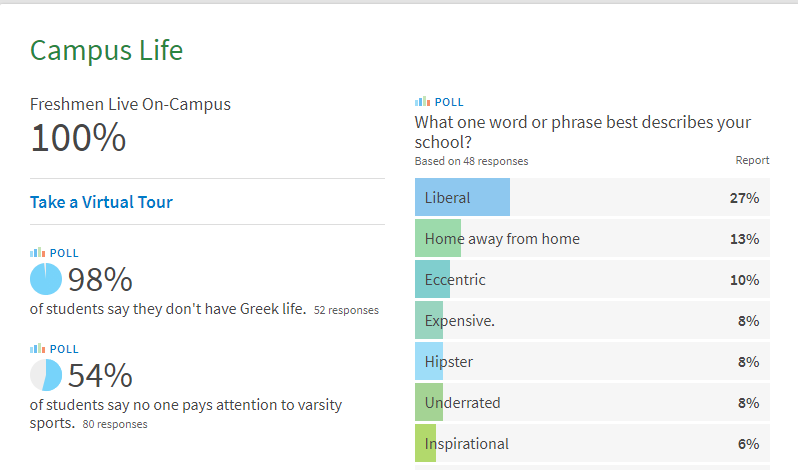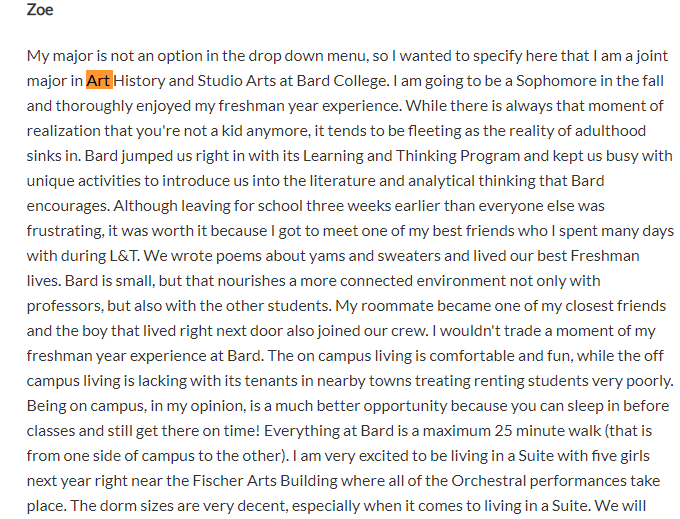Bard College is a renowned private university in New York, founded in the 19th century. It is ranked in the top 200 universities in the world in the field of art and design. The college has an educational network of more than 35 affiliated programs, institutes, and centers, covering twelve cities, five states, seven countries, and four continents. It invites its students to create their own curriculum, focusing on their own preferences, as suggested by the liberal arts model. The combination of disciplinary and interdisciplinary programs allows students to develop critical and creative thinking effectively. The university aims at the formation of students capable of effective and productive activity in the post-industrial world. In this analysis, it is necessary to determine the quality of the bachelor’s program of study at Bard College in Art History and Visual Culture. It is intended to use a participant-oriented approach in the assessment since this will consider the opinions of actual program participants based on the authentic learning experience.
Many people believe that other people’s comments about their interactions with a service or product are unreliable sources of information. They think that the opinion may not be objective and consider only specific aspects and not the overall quality (Elliott, 2018). Some study programs’ participants are reluctant to share their university experience with others, for which no one can blame them. However, it sometimes turns out that only active students’ voices can be heard, and their position may differ from those who prefer to refrain from commenting. Thus, among the weaknesses of this approach is possible to bias and not consider the opinions of all participants.
This assessment method is aimed at learning from the obtained lessons. Due to negative feedback about the program, its managers can correct specific moments in the implementation. devoid of logic. In particular, the program participants’ comments can help create an individualized study schedule that suits the needs of the learners (Lindner & Schwab, 2020). Reviews help the potential customer eliminate doubts about a particular program or help in the final selection from several similar options. Individuals interested in the success of the training program obtain estimates based on empirical results. Since the users themselves point out errors, there is a guarantee that students and university staff will approve the adjustments made.
This approach assumes that knowledge is created by people and not discovered by them. During the participant-based evaluation, competing stakeholders’ opinions are considered (Berk, 2018). Moreover, such a consideration of all views does not have the goal of creating a conflict. On the contrary, it aims to find compromises and identify the strengths and weaknesses of the program through the mutual exchange of points of view. Accordingly, another characteristic of this approach is its flexibility. This feature is manifested when, during the participants’ meeting, the current problems of the program’s implementation are clarified. However, when obtaining the results, what is important to note is that specific changes need to be made following the analysis results; otherwise, there is no efficiency in collecting and analyzing them.
Since the majority’s opinion is assessed, participants feel their contribution and are responsible for their comments about the educational program. Moreover, according to the same logic, the argumentation must be high; otherwise, the initiatives for change will not be taken seriously. The high quality of the arguments consists of the logical and factual validity of the statements, so the assessment of the program will not only be confirmed by the participants’ experience but also by specific statistics.
Even though many people think the method used is not reliable enough, its use seems to be justified for this analysis. There is no need for graduate students to exaggerate or underestimate the quality of their educational institution. Instead, it will be more critical for them to preserve the objectivity of the narrative so that it would be easier for future incoming students to decide whether they should enroll in the university. The information posted on the university website does not always correspond to reality (Friedman, 2017). Therefore, the insider data of the participants of the program will be of significant assistance in assessment (Fleming, 2018). In any case, when evaluating the quality of the program based on a participants-oriented approach, it should be borne in mind that one’s own opinion can be fundamentally different from all the reviews studied (Burbach et al., 2020). Regardless of which site the comments are posted on, it is essential to make sure the review is valid and benefit from the information received. The point of view of each user is subjective; fully trusting it is irrational.
Thus, a potential weakness of this approach is the lack of reliability of the feedback received about the program. The method’s strengths include the empirical nature of research and the ability to make changes based on participant comments quickly. In the future, a problem may arise when it is necessary to find out how easy it is for university graduates to find work and what their salaries are. In this case, it will again be appropriate to use this method, but it will be essential to check the accuracy of the data obtained. However, the same would have to be done even if a different approach was used (Mohajan, 2017). The accuracy of the data is vital for any study.
According to the students’ survey results, it was discovered that 86% of students agree that professors put a lot of effort into teaching. Also, most of the students believe that they can deal with the study load easily. In addition, they think that in Bard, students can easily choose the courses they like. (Figure 1).

When describing their place of study, students use adjectives such as eccentric, liberal, and expensive (Figure 2).

The characteristics that apply to the university as a whole may well be suitable for a specific training program, including the one analyzed in this work.
An example of a detailed review of a program posted on the Unigo website can be used to demonstrate how a participant-oriented approach to evaluation works. Zoe shares her personal feelings and writes about how her school took her time with unique activities (Figure 3).

More generally, she notes Bard College’s convenient location and positive dormitory living experience. The training program allowed her to make new friends but also gain academic knowledge. Zoe’s feedback can be considered not biased since she shares her personal experience. She did not pursue the goal of somehow discrediting the university in the eyes of other students to promote the educational services of another school. The focus of Zoe’s attention was to share own impressions and not write about how well the subjects were taught during her studies. However, it should not be forgotten that the emotional component of the feedback on the program is vital. People can effectively receive education only in comfortable conditions, including a friendly team, supporting teachers, and the convenience of the university’s location.
For this study, it was required to select a training program for its subsequent assessment according to the chosen method. The curriculum is a bachelor’s program, implemented by Bard College, in which students study Art History. It was decided to use a participant-oriented approach during the assessment. The discovered properties of this method corresponded to the conditions of the study. This approach allows universities to minimize the risks of a situation when changes made to the program are unnecessary. During the study, it was possible to find feedback from participants in a specific program being analyzed and general feedback from students and employees of Bard College. It was possible to find both strengths and weaknesses of the one approach selected. In addition, during the work, it became clear what future needs for evaluation this program may have and whether or not the approach would also be helpful then. Based on the students of the educational institution feedback of the analyzed program, it was demonstrated how this method helps assess the quality of the educational program.
Even though the participant-oriented approach to evaluation has its drawbacks, in general, it can be effectively applied to the assessment of educational programs. The essence of the principle is that the participants share their experience of interacting with the analyzed program. In using this approach, as many votes as possible must be taken into account to avoid bias. In general, the method can be compared to leaving reviews for a product or service on the Internet. But the fundamental difference is the need to check the validity of the comments of the participants. In addition, for the effectiveness of the assessment, it is assumed to create a service where students or university staff can share their thoughts. Moreover, specific actions should be done based on the data obtained.
References
Bard College (n.d.). Niche. Web.
Bard College reviews. (n.d.). Unigo. Web.
Berk, Ş. (2018). Assessment of Public schools’ out-of-school time academic support programs with participant-oriented evaluation. Journal of Education and Learning, 7(3), 159-175. Web.
Burbach, L., Halbach P.,, Ziefle M., & Calero, Valdez André. (2020). Opinion formation on the Internet: The influence of personality, network structure, and content on sharing messages online. Frontiers in Artificial Intelligence, 3(45), 1-16. Web.
Elliott, C. (2018). This is why you should not trust online reviews. Forbes. Web.
Fleming, J. (2018). Recognizing and resolving the challenges of being an insider researcher in work-integrated learning. International Journal of Work-Integrated Learning, 19(3), 311-320.
Friedman, J. (2017). 10 red flags an online degree program is fake. U.S. News & World Report. Web.
Lindner, K.-T. & Schwab, S. (2020) Differentiation and individualisation in inclusive education: A systematic review and narrative synthesis. International Journal of Inclusive Education, 1-21. Advance online publication. Web.
Mohajan, H.K. (2017). Two criteria for good measurements in research: Validity and reliability. Annals of Spiru Harat University Economic Series, 17(4), 59-82. Web.
